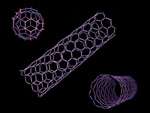Fullerenes and nanotubes are back in the news

Shaped carbon molecules are known officially as fullerenes and unofficially as ''buckyballs''. The news blurbs about Carbon-50, self-assemble nanotubes and fullerene transistors are circulating around the Net. But is this all still about a technology ''not for another few years yet'' or ''we are definitely getting closer''?
Nanotubes self-assemble into circuit elements EETimes
Nanotubes measuring just 100 atoms in diameter have been created from designer molecules that were customized to self-assemble into angstrom-sized circuit elements, according to researchers at Purdue University. Professor Hicham Fenniri's research group developed the nanotube "parent" molecules, which self-assemble in water first into tiny rings. The rings then snap together into long tubes. The outside of the seed molecules harbor "hooks" on which to hang other molecules, which functionalize the resulting nanotube for a specific electronic application.
We have one component of a circuit now — the wire — but the other components, like transistors and transducers, are not all going to be made from the same material," said Fenniri. Instead, "we will use nanolithography to basically write on a substrate, but the ink will be nanotubes.
C60 increases gain in organic-metal-semiconductor transistors PhysOrg
As we reported earlier, the group of scientists from Brazil and UK implemented C60 to metal-base transistor technology. They used evaporated C60 as the emitter in a vertical transistor structure with Au base and Si collector. The proportion of emitted electrons that overcome the barrier is measured as at least 0.99. This metal-base transistor is easy to fabricate as it does not involve wafer bonding or require perfect semiconductor-on-metal growth.
Metal-base transistors (MBT) with C60 as the emitter material solve problems of inorganic MBTs, as having higher current gains, as well as being easier to fabricate.
High-speed nanotubes PhysicsWeb
Scientists have demonstrated, for the first time, that transistors made from single-walled carbon nanotubes can operate at extremely fast microwave frequencies, opening up the potential for better cell phones and much faster computers, perhaps as much as 1,000 times faster. The findings, reported in the April issue of Nano Letters, add to mounting enthusiasm about nanotechnology's revolutionary potential. "Since the invention of nanotube transistors, there have been theoretical predictions that they can operate very fast," said Peter Burke, a professor of electrical engineering and computer science at the University of California, Irvine, and lead author of the paper. At present, the device only works at 4 kelvin but Burke is confident that it can be made to operate at room temperature. Moreover, he believes that the transistor could be made to switch at even higher frequencies. "I estimate that the theoretical speed limit for these transistors should be terahertz (1012 Hertz)," he said.
Anyhow, this all is obviously still in the proof of concept stage, but when you add it to the self-assembling nanotubes, organic MBT’s, and other remarkable properties already reported, we're definitely getting closer. At the same time aren’t we running ahead of reality, forgetting about economic context? Will fullerene technology be as cost-effective as silicon technology nowadays? These questions have still to be answered.

















